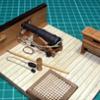-
Posts
3,084 -
Joined
-
Last visited
Reputation Activity
-
 Jaager got a reaction from Canute in HELP - questions regarding micro drill bits/drill press
Jaager got a reaction from Canute in HELP - questions regarding micro drill bits/drill press
The stay sharp longer carbide bits are the wrong type for us. They are for steel and for use in a precision machine. The characteristic that makes them hold their edge also makes them brittle.
Hand held - pin vise or a rotary tool - and probably miniature drill press - into wood - involves a bit of flex at the beginning of the bore. Carbide is not up to this abuse.
I don't know what a $30.50 bit can do, but I mainly suspect that the seller is trolling for dupes.
I think HHS is the type we want. Quality steel yields a degree of survival from flex. Bright is my choice.
I go with domestic manufacturers if given the option.
Here is a company that is a supplier - not a manufacturer - but with #70 bits at ~ $1.00 each - it will not cost much to test their products.
https://www.cmlsupply.com/bright-finish/
Up scale mills used as a drill press is practical if you do a lot of work with steel too.
We have had an on going vigorous debate about drill press choices. Do a search in the tool forum for hours of discussion. I suspect that when a subject has a lot of different favorites as for finding the right answer, that there are a lot of right answers.
The utility of a drill press depends on your style of building. For some, it is a door stop. For some, it is an everyday tool.
-
 Jaager got a reaction from BANYAN in HELP - questions regarding micro drill bits/drill press
Jaager got a reaction from BANYAN in HELP - questions regarding micro drill bits/drill press
The stay sharp longer carbide bits are the wrong type for us. They are for steel and for use in a precision machine. The characteristic that makes them hold their edge also makes them brittle.
Hand held - pin vise or a rotary tool - and probably miniature drill press - into wood - involves a bit of flex at the beginning of the bore. Carbide is not up to this abuse.
I don't know what a $30.50 bit can do, but I mainly suspect that the seller is trolling for dupes.
I think HHS is the type we want. Quality steel yields a degree of survival from flex. Bright is my choice.
I go with domestic manufacturers if given the option.
Here is a company that is a supplier - not a manufacturer - but with #70 bits at ~ $1.00 each - it will not cost much to test their products.
https://www.cmlsupply.com/bright-finish/
Up scale mills used as a drill press is practical if you do a lot of work with steel too.
We have had an on going vigorous debate about drill press choices. Do a search in the tool forum for hours of discussion. I suspect that when a subject has a lot of different favorites as for finding the right answer, that there are a lot of right answers.
The utility of a drill press depends on your style of building. For some, it is a door stop. For some, it is an everyday tool.
-
 Jaager got a reaction from HardeeHarHar in HELP - questions regarding micro drill bits/drill press
Jaager got a reaction from HardeeHarHar in HELP - questions regarding micro drill bits/drill press
The stay sharp longer carbide bits are the wrong type for us. They are for steel and for use in a precision machine. The characteristic that makes them hold their edge also makes them brittle.
Hand held - pin vise or a rotary tool - and probably miniature drill press - into wood - involves a bit of flex at the beginning of the bore. Carbide is not up to this abuse.
I don't know what a $30.50 bit can do, but I mainly suspect that the seller is trolling for dupes.
I think HHS is the type we want. Quality steel yields a degree of survival from flex. Bright is my choice.
I go with domestic manufacturers if given the option.
Here is a company that is a supplier - not a manufacturer - but with #70 bits at ~ $1.00 each - it will not cost much to test their products.
https://www.cmlsupply.com/bright-finish/
Up scale mills used as a drill press is practical if you do a lot of work with steel too.
We have had an on going vigorous debate about drill press choices. Do a search in the tool forum for hours of discussion. I suspect that when a subject has a lot of different favorites as for finding the right answer, that there are a lot of right answers.
The utility of a drill press depends on your style of building. For some, it is a door stop. For some, it is an everyday tool.
-
 Jaager got a reaction from allanyed in Placement of Trennails or bolts in Standards/Bollards
Jaager got a reaction from allanyed in Placement of Trennails or bolts in Standards/Bollards
I can imagine that instead of a raised iron bolt head, because of rusting, the bolt would be counter sunk, then a packing of waterproofing gunk, then a wooden plug. The plug grain oriented with the standard grain, so that only an outline would be visible and if painted, that detail hidden by the paint?
As far as authenticity - nothing may be closer to the mark?
As far as modelers convention - a trunnel - if belt and suspenders is your want - or a brass or copper pin for show.
-
 Jaager got a reaction from mtaylor in Placement of Trennails or bolts in Standards/Bollards
Jaager got a reaction from mtaylor in Placement of Trennails or bolts in Standards/Bollards
I can imagine that instead of a raised iron bolt head, because of rusting, the bolt would be counter sunk, then a packing of waterproofing gunk, then a wooden plug. The plug grain oriented with the standard grain, so that only an outline would be visible and if painted, that detail hidden by the paint?
As far as authenticity - nothing may be closer to the mark?
As far as modelers convention - a trunnel - if belt and suspenders is your want - or a brass or copper pin for show.
-
 Jaager got a reaction from mtaylor in Proportion of Spars
Jaager got a reaction from mtaylor in Proportion of Spars
In which case, go with the max allowed: twice the beam.
-
 Jaager got a reaction from Keith Black in Proportion of Spars
Jaager got a reaction from Keith Black in Proportion of Spars
In which case, go with the max allowed: twice the beam.
-
 Jaager got a reaction from Canute in PVA glue as a sealant for wood
Jaager got a reaction from Canute in PVA glue as a sealant for wood
A primer of half saturated shellac is easily applied using a cotton rag - a worn out T shirt or bed sheet - it soaks into the wood. Using the rag - no ponds are left on the surface - it does not hide detail.
Indeed, if you had used an open pore wood species like Oak or Walnut, the open pores would still be there. The application is less involved than using an air brush. It is quick and simple to use. It takes many applications of full strength to build any sort of thickness - an application is just a wet layer, not a coat.
Use scrap wood and practice a few times - you will then realize that it is not as complicated as imagined. You can buff with a Scotch Brite pad when dry - 0000 steel wool is traditional, but the steel shards - not seen, but there - make themselves known when they turn to rust and leave a stain.
-
 Jaager got a reaction from DaveBaxt in PVA glue as a sealant for wood
Jaager got a reaction from DaveBaxt in PVA glue as a sealant for wood
A primer of half saturated shellac is easily applied using a cotton rag - a worn out T shirt or bed sheet - it soaks into the wood. Using the rag - no ponds are left on the surface - it does not hide detail.
Indeed, if you had used an open pore wood species like Oak or Walnut, the open pores would still be there. The application is less involved than using an air brush. It is quick and simple to use. It takes many applications of full strength to build any sort of thickness - an application is just a wet layer, not a coat.
Use scrap wood and practice a few times - you will then realize that it is not as complicated as imagined. You can buff with a Scotch Brite pad when dry - 0000 steel wool is traditional, but the steel shards - not seen, but there - make themselves known when they turn to rust and leave a stain.
-
 Jaager got a reaction from shipman in HMS Tiger 1747 by Siggi52 - 1:48 - 60 gun ship from NMM plans
Jaager got a reaction from shipman in HMS Tiger 1747 by Siggi52 - 1:48 - 60 gun ship from NMM plans
Thinking about it, it sort of makes sense. I think that the channels are parallel to the midline. The data points in the Establishments are the place where they are most narrow. For the mizzen, the slope of the tops is a small rate of change. That said, I would probably still make it parallel - then the after end would be slightly wider. They would not be parallelograms when viewed from above, they would be a section of a large triangle. (Plane Geometry was in 1962 and I forget the name of a 4 side with all sides unequal.)
OR
if it is parallel with the side of the ship, only the one data point would be needed. In this case they would be parallelograms.
-
 Jaager got a reaction from shipman in HMS Tiger 1747 by Siggi52 - 1:48 - 60 gun ship from NMM plans
Jaager got a reaction from shipman in HMS Tiger 1747 by Siggi52 - 1:48 - 60 gun ship from NMM plans
I have not seen the term before, but on an open boat, the painter is a section of rope at the bow that is used to tie it to the back of the ship - or whatever else is towing it. It supplies a metaphor? for removing someone from your support: " cutting the painter". To fit that name, I would guess that the chain is a relatively short length with the distant end not attached to anything - until it is used to temporarily secure an anchor or boat.
Looking at your deadeyes, I wonder if a two part strop would work?
1- a belt that wraps around the body with ends that meet at the bottom.
2- a hole in the deadeye at that bottom site where an eye is glued into the hole. The end of the eye being a pointed tap - twisted?
Would this be faster to mass produce? I can see that a two part epoxy would make this a "forever" unit.
-
 Jaager got a reaction from shipman in HMS Tiger 1747 by Siggi52 - 1:48 - 60 gun ship from NMM plans
Jaager got a reaction from shipman in HMS Tiger 1747 by Siggi52 - 1:48 - 60 gun ship from NMM plans
Siggi,
Goodwin describes a canvas "boot" with a secure rope binding at the top and a on-off rope binding at the deck level. It was tar coated.
The bottom was removable for inspection - especially after a storm. These would likely be at every deck that is subject to flooding. I can't see how the bottom could be tied down unless some sort of wedge - even if loose - was in place.
-
 Jaager got a reaction from mtaylor in PVA glue as a sealant for wood
Jaager got a reaction from mtaylor in PVA glue as a sealant for wood
A primer of half saturated shellac is easily applied using a cotton rag - a worn out T shirt or bed sheet - it soaks into the wood. Using the rag - no ponds are left on the surface - it does not hide detail.
Indeed, if you had used an open pore wood species like Oak or Walnut, the open pores would still be there. The application is less involved than using an air brush. It is quick and simple to use. It takes many applications of full strength to build any sort of thickness - an application is just a wet layer, not a coat.
Use scrap wood and practice a few times - you will then realize that it is not as complicated as imagined. You can buff with a Scotch Brite pad when dry - 0000 steel wool is traditional, but the steel shards - not seen, but there - make themselves known when they turn to rust and leave a stain.
-
 Jaager got a reaction from billocrates in HMS ANSON 1781 by albert - 1/48 - 64 guns
Jaager got a reaction from billocrates in HMS ANSON 1781 by albert - 1/48 - 64 guns
HMS Anson 1781 second group of the Intrepid class 64 gun
1st class
Intrepid 1779 1771
Monmouth 1772 1778
Defiance 1772 1778
Nonsuch 1774 1776
Ruby 1776 1778
2nd class
Vigilant 1774
Eagle 1774 1776
America 1777 1778
Anson 1781
Polyphemus 1782
Magnanime 1780
Sampson 1781
Repulse 1780
Diadem 1782 1783
Standard 1782
This class is one of the more documented designs
ZAZ
1486 lines L37 J3635
1487 frames 45 3682
1488 inboard
1489 orlop
1490 GD
1491 UD
1409 orlop 34 3242
1410 GD 34 3241
1311 UD 34 3240
1412 QD/FC 32 3239
If no print has ever been ordered and is not in stock: no price
The NMM wed site has the J# but does not identify them.
-
 Jaager got a reaction from Saburo in HMS ANSON 1781 by albert - 1/48 - 64 guns
Jaager got a reaction from Saburo in HMS ANSON 1781 by albert - 1/48 - 64 guns
HMS Anson 1781 second group of the Intrepid class 64 gun
1st class
Intrepid 1779 1771
Monmouth 1772 1778
Defiance 1772 1778
Nonsuch 1774 1776
Ruby 1776 1778
2nd class
Vigilant 1774
Eagle 1774 1776
America 1777 1778
Anson 1781
Polyphemus 1782
Magnanime 1780
Sampson 1781
Repulse 1780
Diadem 1782 1783
Standard 1782
This class is one of the more documented designs
ZAZ
1486 lines L37 J3635
1487 frames 45 3682
1488 inboard
1489 orlop
1490 GD
1491 UD
1409 orlop 34 3242
1410 GD 34 3241
1311 UD 34 3240
1412 QD/FC 32 3239
If no print has ever been ordered and is not in stock: no price
The NMM wed site has the J# but does not identify them.
-
 Jaager got a reaction from Mic_Nao in HMS ANSON 1781 by albert - 1/48 - 64 guns
Jaager got a reaction from Mic_Nao in HMS ANSON 1781 by albert - 1/48 - 64 guns
HMS Anson 1781 second group of the Intrepid class 64 gun
1st class
Intrepid 1779 1771
Monmouth 1772 1778
Defiance 1772 1778
Nonsuch 1774 1776
Ruby 1776 1778
2nd class
Vigilant 1774
Eagle 1774 1776
America 1777 1778
Anson 1781
Polyphemus 1782
Magnanime 1780
Sampson 1781
Repulse 1780
Diadem 1782 1783
Standard 1782
This class is one of the more documented designs
ZAZ
1486 lines L37 J3635
1487 frames 45 3682
1488 inboard
1489 orlop
1490 GD
1491 UD
1409 orlop 34 3242
1410 GD 34 3241
1311 UD 34 3240
1412 QD/FC 32 3239
If no print has ever been ordered and is not in stock: no price
The NMM wed site has the J# but does not identify them.
-
 Jaager got a reaction from Bob Cleek in Split ring making process
Jaager got a reaction from Bob Cleek in Split ring making process
There is a shop note - I have not saved the author's name or journal reference - but he got a much longer life from his disks by coating one side with epoxy glue - I think the watery clear flavor epoxy.
-
 Jaager got a reaction from allanyed in Split ring making process
Jaager got a reaction from allanyed in Split ring making process
The technique that I read and stored in memory:
a drill with a shank diameter equal to the inside diameter of the rings
brass or copper wire that is the diameter of the ring body
wrap a tight coil of the wire around the drill shank
saw the coil = lots of open rings
solder
I am wondering if a resistance solder machine would play nice for this?
A plot devise in "Crash and Burn" had a primary character go loony from breathing the heavy metals in circuit board solder - so I good ventilation with soldering may be prudent.
Copper and brass are ductile - with a jewelers draw plate, theoretically one fat wire can be drawn down to any diameter desired.
There is more to it than that - for brass at least - working it causes it to harden - it gets harder to pull
Heat will harden Fe - I think heat will soften brass and maybe Cu?
-
 Jaager got a reaction from wefalck in Split ring making process
Jaager got a reaction from wefalck in Split ring making process
The technique that I read and stored in memory:
a drill with a shank diameter equal to the inside diameter of the rings
brass or copper wire that is the diameter of the ring body
wrap a tight coil of the wire around the drill shank
saw the coil = lots of open rings
solder
I am wondering if a resistance solder machine would play nice for this?
A plot devise in "Crash and Burn" had a primary character go loony from breathing the heavy metals in circuit board solder - so I good ventilation with soldering may be prudent.
Copper and brass are ductile - with a jewelers draw plate, theoretically one fat wire can be drawn down to any diameter desired.
There is more to it than that - for brass at least - working it causes it to harden - it gets harder to pull
Heat will harden Fe - I think heat will soften brass and maybe Cu?
-
 Jaager got a reaction from mtaylor in Split ring making process
Jaager got a reaction from mtaylor in Split ring making process
There is a shop note - I have not saved the author's name or journal reference - but he got a much longer life from his disks by coating one side with epoxy glue - I think the watery clear flavor epoxy.
-
 Jaager got a reaction from Canute in Split ring making process
Jaager got a reaction from Canute in Split ring making process
The technique that I read and stored in memory:
a drill with a shank diameter equal to the inside diameter of the rings
brass or copper wire that is the diameter of the ring body
wrap a tight coil of the wire around the drill shank
saw the coil = lots of open rings
solder
I am wondering if a resistance solder machine would play nice for this?
A plot devise in "Crash and Burn" had a primary character go loony from breathing the heavy metals in circuit board solder - so I good ventilation with soldering may be prudent.
Copper and brass are ductile - with a jewelers draw plate, theoretically one fat wire can be drawn down to any diameter desired.
There is more to it than that - for brass at least - working it causes it to harden - it gets harder to pull
Heat will harden Fe - I think heat will soften brass and maybe Cu?
-
 Jaager got a reaction from Canute in Split ring making process
Jaager got a reaction from Canute in Split ring making process
There is a shop note - I have not saved the author's name or journal reference - but he got a much longer life from his disks by coating one side with epoxy glue - I think the watery clear flavor epoxy.
-
 Jaager got a reaction from Snug Harbor Johnny in Split ring making process
Jaager got a reaction from Snug Harbor Johnny in Split ring making process
There is a shop note - I have not saved the author's name or journal reference - but he got a much longer life from his disks by coating one side with epoxy glue - I think the watery clear flavor epoxy.
-
 Jaager got a reaction from Dave_E in Split ring making process
Jaager got a reaction from Dave_E in Split ring making process
There is a shop note - I have not saved the author's name or journal reference - but he got a much longer life from his disks by coating one side with epoxy glue - I think the watery clear flavor epoxy.
-
 Jaager got a reaction from mtaylor in Split ring making process
Jaager got a reaction from mtaylor in Split ring making process
The technique that I read and stored in memory:
a drill with a shank diameter equal to the inside diameter of the rings
brass or copper wire that is the diameter of the ring body
wrap a tight coil of the wire around the drill shank
saw the coil = lots of open rings
solder
I am wondering if a resistance solder machine would play nice for this?
A plot devise in "Crash and Burn" had a primary character go loony from breathing the heavy metals in circuit board solder - so I good ventilation with soldering may be prudent.
Copper and brass are ductile - with a jewelers draw plate, theoretically one fat wire can be drawn down to any diameter desired.
There is more to it than that - for brass at least - working it causes it to harden - it gets harder to pull
Heat will harden Fe - I think heat will soften brass and maybe Cu?













